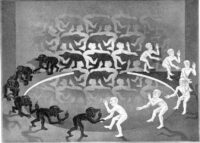All language is metaphor, and for that matter, so is every word in every language. We humans are metaphor-makers, and making metaphor means making meaning.
Words create a nominal, or language-based reality which generates internal image-ideas. Through a process of fine-grained description we jointly settle on conventionally accepted words which sufficiently convey each metaphor we express to others.
For example, if I say “table” an internal image-idea arises, generally one including four legs of equal length and a flat top resting securely on the four legs. The word “table” is not, of course, an actual table; it is this representative imaginary aspect which is metaphorically-based. “Table” might suffice in a sentence such as “We sat and had dinner at a table, enjoying a hearty bowl of pasta with Bolognese sauce.” The primary focus of this sentence is the pasta and enjoyment of the meal, thus a more detailed description of the table is not necessary. However, syntax in large part governs which part of the sentence is important; if the sentence said “remarkable table” the emphasis would shift.
Thus our descriptions of tables are as diverse as tables themselves. We use our powers of discrimination, awareness of table types and image-making metaphors to convey specific information to others of increasing complexity. Thus size, color, materials, measurements, weight, design, age, identifying marks and value are among the many elaborations brought to bear on nominal table metaphor-making.
This same process is brought to bear on each and every detail of existence. Both objects and ideas are subject to vast elaboration, or one could say, construction. Precision in metaphor-making requires vocabulary to match each observed state, nuance, transition, moment, quality, nature, duration, and so forth. Even at this level, the underlying structure of matter is subject to further metaphorical refinement, reaching all the way down to sub-atomic particles, forces and fields. The now famous Higg’s Boson, for example, associated with imparting mass to all sub-atomic particles, is simply the deepest metaphor currently available to nominally describe the subtlest forms of physical and observable reality.
It is worth noting that words are not required for existence. As sentient beings we enjoy an inherent awareness directly perceived via our sensory apparatus and then processed and accommodated by both sub-conscious reflexive activity and acquired conditioned reactions borne of past experience. This is how other animals survive. We need not make metaphor unless we wish to convey information to others through verbal communication. It would appear that for the purposes of individual survival, direct experience seems largely sufficient.
This last point ignores the social reality of life, however. The extended period of human childhood, among the lengthiest in the animal world, is clearly the essential and seminal period for practicing and understanding metaphor-making. Deprived of this imaginative ability, human social life is impossible. Thus children are taught how to master the complex social metaphors which govern matters of behavior, livelihood and safety.
Ultimately, metaphor as communication is dependent upon resonance. Resonance – the emotional harmonic between people which when attuned provides the basis for receptivity and exchange – is the ground upon which metaphor rests. Lacking resonance we remain unknowable strangers, an unacceptable emotional state of isolation antithetical to our social nature. Accordingly, attuning one’s resonant emotional frequency to others underlies metaphor-making and all forms of communication.





Be First to Comment